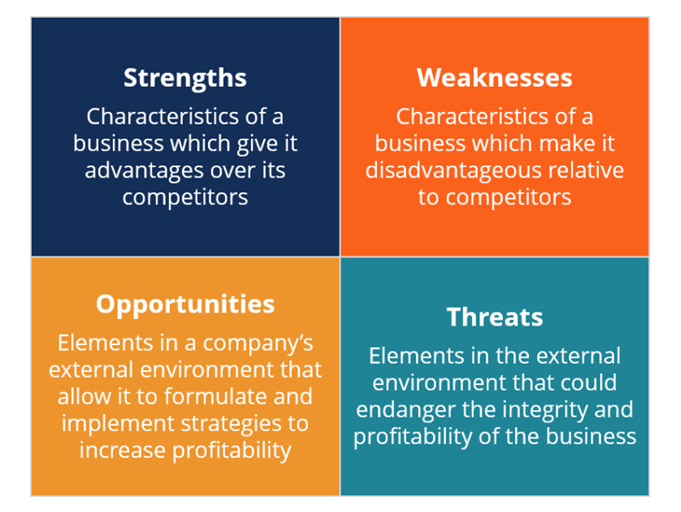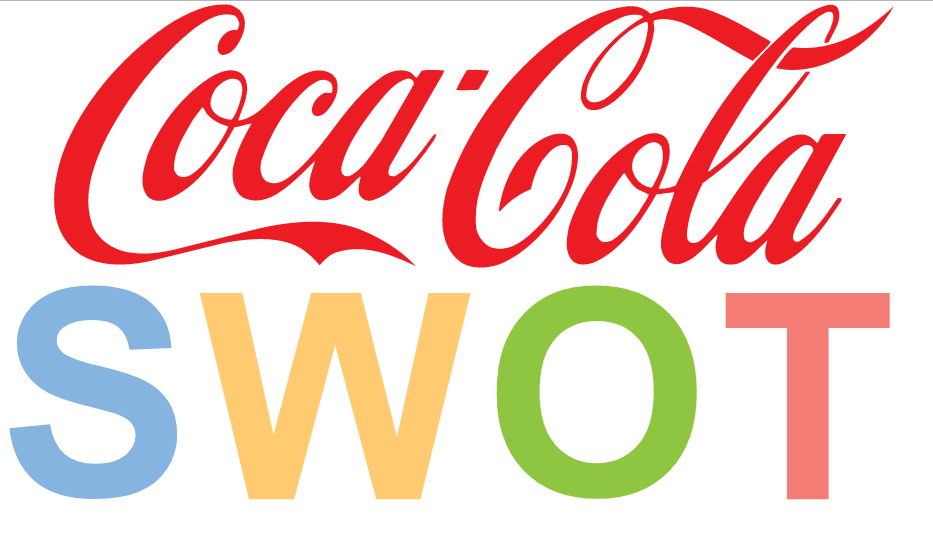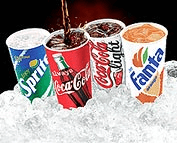
SWOT Analysis, also referred to as SWOT matrix is a handy strategic planning technique used to help an organization or a person understand their strengths and weaknesses, and also used for identifying potential business opportunities and threats that you might face.
It is also used to highlight internal and external factors that are either in favor or not in favor of your business objectives or goals. In order to generate meaningful information users of SWOT analysis frequently ask themselves questions and come up with logical answers which makes it a useful tool to identify their competitive edge.
Strengths and weaknesses are often related to internal factors, whereas the external factors come under the matrices of threat and opportunities. The word SWOT is basically an acronym for the four parameters that constitute the framework of the technique, the below explained by the Essay help UK can make students understand the concept at the basic level.

Strategic fit is a concept that measures the extent to which the external environment of the firm matches the internal environment of the firm. In order to plan the steps to achieve the strategic goals, identification of SWOT is an essential tool because it gives you a long term perspective of different factors. First and foremost, given the SWOTs, the decision makers should identify whether the objective is attainable or not, if not then they should select a different objective and repeat the same process.
The utility of SWOT analysis is not restricted only to profit-pursuing organizations. In any decision-making situation where the desired goals of the company are properly defined, SWOT may be put to good use for example, government bodies, non-profit organizations, and individuals. Pre-crisis management or preventive management is another situation where SWOT analysis is used. Furthermore, for the purpose of creating recommendations during a viability survey, SWOT is used.
Let’s further give some insight to where these SWOT Analysis examples can be fit. Building a Strategy:
Organizational or personal strategic planning is an area where the SWOT matrix can be effectively applied. The steps that are essential to execute the procedure situated investigation include distinguishing proof of interior and exterior components (utilizing the well known 2x2matrix), determination and assessment of the most significant variables, and ID of relations existing among inner and outer highlights.
For example, solid relations among qualities and openings can recommend great conditions in the organization and permit utilizing a forceful methodology. Then again, solid collaborations among shortcomings and dangers could be examined as a potential cautioning and guidance for utilizing a cautious methodology.
Matching and converting is another route to applying SWOT. Matching is utilized to discover the organization's competitive edge by coordinating the qualities (strengths) to opportunities. Another strategy is to convert the shortcomings or dangers into qualities or opportunities. An example of the conversion tactic is to discover new avenues or markets. In the event that the dangers or shortcomings can't be changed over, an organization should attempt to limit or evade them.
Corporate planning is an organized/systematic process that is used by an organization to devise strategies and plans for them to achieve their strategic targets. PESTLE, SWOT can be used for environmental and business factors. This includes:
In numerous contender analysis, marketers create elaborated profiles of every rival in the market, concentrating particularly on their relative competitive qualities and shortcomings utilizing SWOT analysis. Marketing directors will look at every contender's cost structure, sources of benefits, assets and skills, competitive position and product differences, level of vertical integration, chronicled reactions to industry advancements, and different elements.
To carry out effective marketing analysis, management frequently finds it necessary to pour resources in research to collect accurate data. Therefore, management sometimes conducts market research to obtain this knowledge. A number of techniques are applied by marketers to perform market research, some of the techniques are mentioned below:
Below is an example SWOT analysis of a market position of a small management consultancy with specialism in HRM.
|
Strengths |
Weaknesses |
Opportunities |
Threats |
|
Marketplace reputation |
Shortage of consultants at operating level rather than partner level |
Well established position with a well-defined market niche |
Large consultancies operating at a minor level |
|
Expertise at partner level in HRM consultancy |
|
Identified market for consultancy in areas other than HRM
|
Other small consultancies looking to invade the marketplace |
As talked about above, in order to execute a successful project, SWOT analysis is a crucial step. It has been observed that it is very often that a city will spend a year or so pondering the risks and benefits of a project before they come to a decision to vote on it.
One of the key factors to consider and understand in a SWOT analysis is the environment or community the organization is operating with in. This can be done by carrying out surveys, via public forums, and informational reviews. The data collected from these surveys will help to educate the local people while doing the analysis. The identifications of the needs of the community and a proper assessment of those needs can prove to be a crucial tool in the process. After the collection of data and assessments are done, an analysis of the community can be carried out that informs the SWOT analysis.
Group settings such as work or community meetings are the best places to develop a SWOT analysis. A moderator can conduct the meeting and briefly explain the concept of SWOT while explaining each term clearly. One of the most effective ways to develop a SWOT analysis create an example SWOT by dividing a large group into smaller teams and then present to a larger group after the allotted time. This activity will allow people who are generally silent in a larger setting to give their inputs as well. After the allotted time has passed, the moderator can collect the individual tasks onto a larger sheet or display and then collectively go through the strengths, weaknesses, opportunities and threats. In this way the community can collectively brainstorm, identify the negatives and then tackle them together.
The SWOT analysis can be used for:
The SWOT analysis of Coca-Cola shows that how an organization that controls one of the most iconic brands, essentially of all time, reached the pinnacle of success and how they became one of the largest beverage manufacturing company across the globe.
The analysis identifies all the important strengths, weaknesses, opportunities and threats that impact the company’s performance the most.

Coca-Cola Company, an American multinational corporation, was incorporated in Atlanta in 1892 by Asa Griggs Chandler. It is one of the largest non-alcoholic beverage manufacturer in the world. The company renowned for its iconic and flagship product Coca-Cola. The beverage itself was invented by John Smith, who by profession was a pharmacist in Atlanta, Georgia.
Although the company’s headquartered was in Atlanta, it has been operating on a franchise based system since 1889. Being one of the largest beverage distributors, the company used to produce approximately 400 beverage brands. The company sells syrups and concentrates to numerous bottling and canning operators, and wholesalers. The organization is driven by its goal of providing “magic” every time a person drinks one its brands across the globe. The chart below will clear all your queries where, when, how this organization came into being.
|
Name |
The Coca-Cola Company |
|---|---|
|
Founded |
May 8, 1886 |
|
Logo |
|
|
Industries served |
Beverage |
|
Geographic areas served |
Worldwide (more than 200 countries) |
|
Headquarters |
Atlanta, Georgia, United States |
|
Current CEO |
James Quincey |
|
Revenue (US$) |
35.410 billion (2017) 15.4% decrease over 41.863 billion (2016) |
|
Profit (US$) |
1.182 billion (2017) 81.9% decrease over 6.527 billion (2016) |
|
Employees |
61,800 (2018) |
|
Main Competitors |
PepsiCo Inc., Dr Pepper Snapple Group, Inc., Unilever Group, Mond?lez International, Inc., Groupe Danone, Kraft Foods Inc., Nestlé S.A. and many other companies in the beverage industry. |
The Coca-Cola Company established its operations in Pakistan in 1953. Out of its various brands, the brands operating in Pakistan are namely Coca-Cola, Sprite and Fanta. The company’s operations in the country are carried out through eight bottlers and four of them are directly owned by the Coca-Cola Beverages Pakistan Limited (CCBPL). The CCBPL plants are situated most of the major cities like Karachi, Hyderabad, Sialkot, Gujranwala, Faisalabad, Rahim Yar Khan, Multan and Lahore. The Coca-Cola operation in Pakistan is directly catering to 70,000 customers or retailers.
The company’s main manufacturing plant which is located in Lahore is capable of refilling 180,000 bottles in one hour. Coca-Cola has 2500,000 customers in the form of shops where their products are distributed.

Coca-Cola has a strong brand recognition and portfolio as it is the leading manufacturer, distributor and marketer of non-alcoholic beverages in the world. The company is an owner of over 400 brands which include sports drinks, energy drinks, tea and juices. The company runs its operations in over 200 countries essentially making 75% percent of its profits overseas.
The biggest threat to the company is its intense negative public image and below par domestic performance. The essay writing service UK has highlighted some points through SWOT Analysis that can let you know what exactly is there power and their weakness.
Weakness in any business are to be closely monitored and minimized or overcome to achieve objectives and goals successfully and Coca-Cola is no exception:
Though helping out with finding the strength, weakness, opportunity and threats we can easily distinguish the possible problems and desirable solutions. Students should now be tension free and stop searching for write my essay, our blog will help students to observe these examples to understand the concepts and added the practical explanations into their essays.
